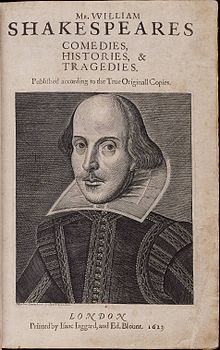Chandos portrait
[5] In 1719, in a note in the margin of a book, George Vertue wrote the name "Richard Burbridge" [sic], then crossed it out.[6] Vertue also states that before the Duke of Chandos acquired it, the portrait was owned by Shakespeare's possible godson, William Davenant (1606–1668),[6][4] who, according to the gossip chronicler John Aubrey, claimed to be the playwright's illegitimate son.[9] Since the man in the Chandos portrait resembles the one in the Droeshout engraving, the similarity lends an indirect legitimacy to the oil painting.George Steevens said that the picture gave Shakespeare "the complexion of a Jew, or rather that of a chimney sweeper in the jaundice".One critic, J. Hain Friswell, insisted 'one cannot readily imagine our essentially English Shakespeare to have been a dark, heavy man, with a foreign expression'."[11] Friswell agreed with Steevens that the portrait had "a decidedly Jewish physiognomy" adding that it displayed "a somewhat lubricious mouth, red-edged eyes" and "wanton lips, with a coarse expression.



John TaylorWilliam ShakespeareNational Portrait GalleryFirst Folio3rd Duke of ChandosNational Portrait Gallery, LondonGeorge VertuePainter-Stainers' companyChildren of Paul'sKatherine Duncan-JonesJoseph TaylorRichard BurbageWilliam DavenantJohn AubreyThomas BettertonJames Brydges, 3rd Duke of ChandosRichard Temple-Grenville, 2nd Duke of Buckingham and ChandosEarl of EllesmereengravingMartin DroeshoutBen JonsonGerard SoestShakespeare Birthplace TrustStratford-upon-AvonTarnya CooperJohn DonneEarl of PembrokeGerard VanderguchtNicholas RoweJacobus HoubrakenphrenologyGeorge SteevensBen MacintyreErnest JonesSigmund FreudTimes Literary SupplementWerner HabichtPortraitsDroeshout portraitAshbourne portraitCobbe portraitFlower portraitSanders portraitShakespeare's funerary monumentHeminges and Condell MemorialCentral Park, New YorkLeicester Square, LondonBritish LibraryMemorialsBoydell Shakespeare GalleryGarrick's Temple to Shakespeare